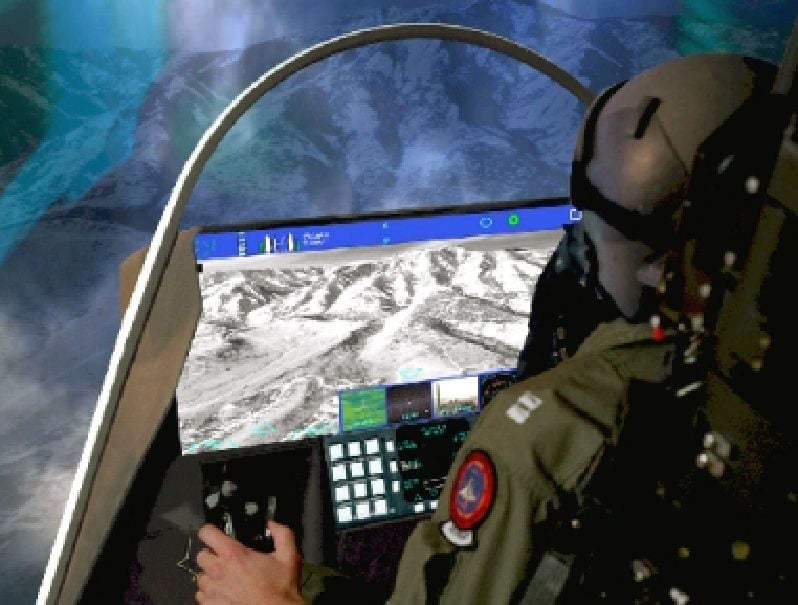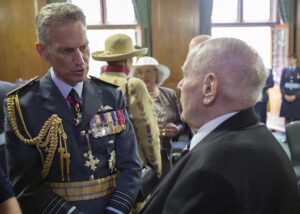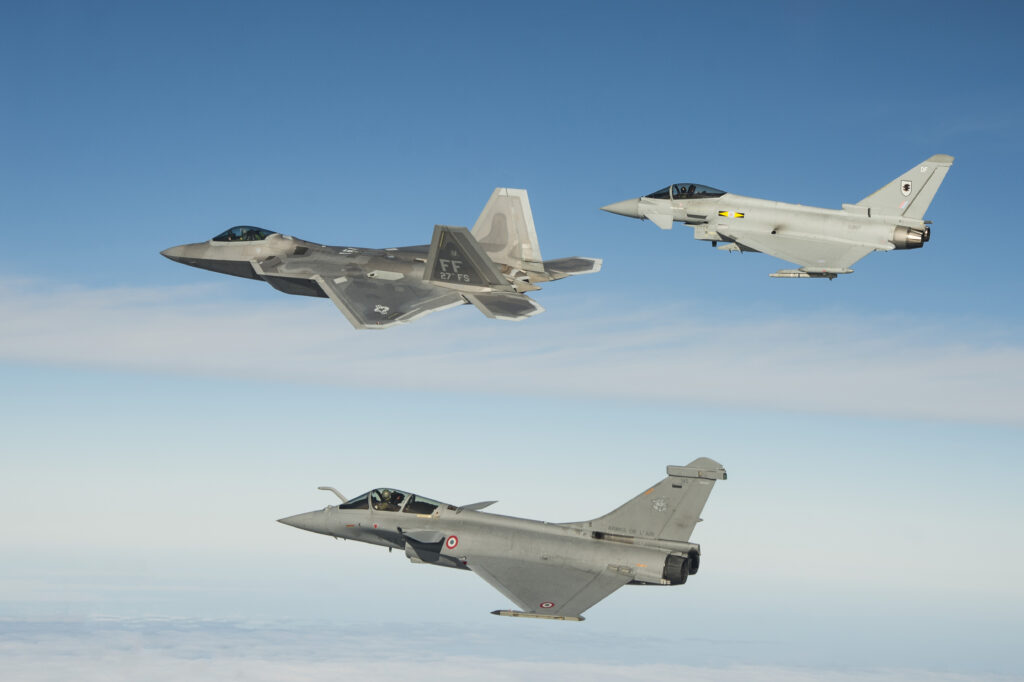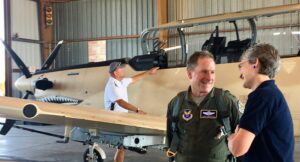“I grew up flying fighters,” says Gen. David Goldfein, the Air Force Chief of Staff, "and I will tell you, when I see the F-35, I don’t see a fighter. I see a computer that happens to fly."
F-35 cockpit
 ARLINGTON: “I grew up flying fighters,” says Gen. David Goldfein, the Air Force Chief of Staff, “and I will tell you, when I see the F-35, I don’t see a fighter. I see a computer that happens to fly.” It’s not just the F-35, Goldfein told a Mitchell Institute audience this morning: “You also have to think about an Aegis cruiser in a different way. You’ve got to think about a Brigade Combat Team in a different way.” “I’m so adamant that, if we start thinking about these systems as not the planes or ships or what have you but as computers we need to connect….it gives you new insight,” Goldfein elaborated to reporters after his public remarks.
ARLINGTON: “I grew up flying fighters,” says Gen. David Goldfein, the Air Force Chief of Staff, “and I will tell you, when I see the F-35, I don’t see a fighter. I see a computer that happens to fly.” It’s not just the F-35, Goldfein told a Mitchell Institute audience this morning: “You also have to think about an Aegis cruiser in a different way. You’ve got to think about a Brigade Combat Team in a different way.” “I’m so adamant that, if we start thinking about these systems as not the planes or ships or what have you but as computers we need to connect….it gives you new insight,” Goldfein elaborated to reporters after his public remarks.
So think in terms of computers that float or submerge; that crawl on tracks or roll on wheels; that fly with rotors or on wings. The platforms we have today — ships, subs, tanks, trucks planes, helicopters, etc. — will mostly still be around in 20 to 30 years, “so the fundamental question then becomes is, how do we connect them,” Goldfein says. “That connective tissue is something all the chiefs are talking about, all moving forward under this concept of multi-domain operations.”
“It’s a unique period of time in the US military,” Goldfein said. “The joint chiefs, we’ve all fought together, and we all fought together and grew under this guy named Jim Mattis (who was the general overseeing the wars in Iraq and Afghanistan before he became Defense Secretary). And you will hear us all talking about this concept of multi-domain operations.”
Air Chief Marshall Sir Stephen Hiller, head of the Royal Air Force, in full uniform
 But what in heaven and earth is a multi-domain operation? Goldfein argues it’s the United States’ decisive “asymmetric advantage.” When people ask him how the F-35 would fare against China’s new J-20 stealth fighter, for example, he tells them “that’s a 20th century discussion,” Goldfein said. “A J-20 is never going to see an F-35 by itself. It’s going to see an F-35 connected to low earth orbiting satellites in several constellations. It’s going to see it connected to penetrating ISR (intelligence, surveillance, and reconnaissance), stand-off ISR, to smart weapons technology, to a light maneuver brigade, to an Aegis cruiser, to our allies and partners.”
But what in heaven and earth is a multi-domain operation? Goldfein argues it’s the United States’ decisive “asymmetric advantage.” When people ask him how the F-35 would fare against China’s new J-20 stealth fighter, for example, he tells them “that’s a 20th century discussion,” Goldfein said. “A J-20 is never going to see an F-35 by itself. It’s going to see an F-35 connected to low earth orbiting satellites in several constellations. It’s going to see it connected to penetrating ISR (intelligence, surveillance, and reconnaissance), stand-off ISR, to smart weapons technology, to a light maneuver brigade, to an Aegis cruiser, to our allies and partners.”
Don’t focus on individual platforms. Focus on the networks, which are advancing at a much faster rate, agreed British Air Chief Marshal Sir Stephen Hillier, speaking alongside Goldfein at a celebration of the Royal Air Force’s centennial. The first battle-winning example of an airpower network was actually the British air defenses in the Battle of Britain, he argued, which used radar to spot the enemy, command posts to correlate the data, fighters to act on it, and radio to connect it all. You probably remember the indelible images of women in uniform moving planes around on a large table, with generals looking down as they leaned on the balustrade above. But today the power of information technology is vastly greater and just keeps growing.
Like the US Air Force, the RAF will be flying many of the same planes in 20 years, Hillier said. “What will be different will be this next generation networked air force (with) air, space and cyber (in an) integral multi-domain process, with command and control that is radically different than the way we do it at the moment — rather than a centralized function, a much more distributed function.”
Foreign liaison personnel in their cloistered section of Central Command’s Combined Air Operations Center (CAOC).
That’s all very lofty techno-optimism, but how do you actually make it work? Government-run mega-programs — especially international ones — have a nasty history of coming in not only over budget but so slowly that they’re obsolete on arrival.
“There is a risk that we see information as a defense acquisition issue (like) previous defense acquisition issues,” Hillier said, “where we say, well, ‘this is what we want to do, we want to join all of these platforms, (so) we will launch a grand project which in 10-15 years time will somehow fuse that all together.'” That didn’t work 15 years agoat the height of the “network-centric” craze and it won’t now, he said.
“How we’ve looked at this before from the military is, ‘we have a requirement, howdoes the technology get developed to meet that requirement?'” Hillier said. (Emphasis ours). What we need to do, he argued, is to see that ” the technology is there — how do we adapt as an organization to best exploit that technology?”
“In defense we have specific, unique requirements, but they are relatively marginal,” Hillier said. “Overall, our requirements are the same as wider industrial sectors. We can exploit commercial technology to a far greater extent than we have done in the past — clearly we need to be aware of security considerations along the way….if we are to have the pace, the tempo, the agility that we need.”
Rather than try to create “some big joint thing that will pull it all together,” Hillier said, “we need to describe a framework we can all operate together within” and let different countries and companies plug-and-play their technology in that framework. (The term of art for this is open architecture).
It’s not impossible, Hillier argued: Cellphones manage this today. “I’ve got a different phone from you, I’ve got a different network that I’m running it on, I’ve got a different set of my apps on my thing, but if I tap in those numbers, your phone will ring,” Hillier said. “It’s that sort of approach we need to take rather than, ‘we all must buy the same phone.'”
“Industry has already solved this in many ways,” Goldfein told reporters. “They’ve already taken a look at how do you actually build the algorithms that can connect computers.”

US F-22 (left) flies with British Typhoon (top right) & French Rafale (bottom). All three nations participated in the recent strikes on Syria.
Open Architecture
This kind of bring-your-own-device approach — be that device a smartphone or an F-35 — relies on everyone agreeing to certain common standards for how the devices interact. (Underneath this common interface, the code for each device can be as quirky, proprietary, and secretive as desired). That’s at odds with the traditional Pentagon process, Goldfein reminded reporters, where the company that wins a contract gets to build a system using its proprietary data formats. The resulting incompatibility between different US systems, let alone US and allied, forces operational commanders into awkward, time-consuming kludges that just won’t be acceptable in the future.
Air Force Chief of Staff Gen. David Goldfein and Secretary Heather Wilson at Holloman AFB for the Light Attack Experiment.
 How to fix this? One way is the Air Force’s $2.4 billion flight tests of propeller-driven ground attack planes with modern electronics, Goldfein said: “The Light Attack Experiment… and it truly is an experiment — is actually not so much about the platform, the sensor or the weapon, (but) an information sharing network that allows us to be more interoperable, that’s coalition at the core.”
How to fix this? One way is the Air Force’s $2.4 billion flight tests of propeller-driven ground attack planes with modern electronics, Goldfein said: “The Light Attack Experiment… and it truly is an experiment — is actually not so much about the platform, the sensor or the weapon, (but) an information sharing network that allows us to be more interoperable, that’s coalition at the core.”
Goldfein’s message for allies and partners? “What you procure is up to you, but….you’re going to want to hitch your wagon to our command and control network,” he said. “Whatever you procure as an individual platform or sensor or weapon…. you’re going to want to be able to tap into the information network, the command and control that we provide.”
“Looking at the future of warfare, how fast are we going to have to sense, decide, and act?” Goldfein asked reporters. “And what command and control network do you need to be able to do that, in an environment where we’re back into peercompetition, with folks who can actually get in and do some things to degrade our systems?”
Against such adversaries, “what you’ve go to do is make sure that you have resiliency built into your system and alternative pathways,” Goldfein said. “If we build this so we have one critical vulnerability, then we’ve gone the wrong way.”

No comments:
Post a Comment